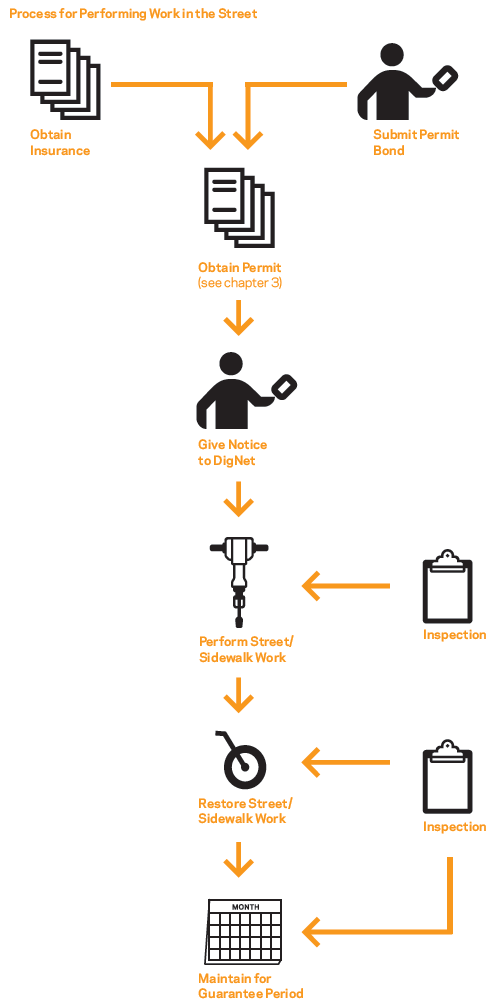Call 911 to report a gas odor or a gas leak.
Permits— In order to perform work in the street, it is necessary to obtain a permit from NYC DOT. Permits are available for various types of work, including Street Opening Permits, Building Operations/Construction Activity Permits, and Sidewalk Construction Permits. The requested permit must be appropriate for the type of work that is planned. Typically, permits must be kept at the work site or designated field headquarters at all times and must be made available for inspection. Further information on permits is available in Chapter 3 Permits and Approvals.
Insurance and Permit Bonds— After initial registration, active permittees must submit proof of all insurance and bonds annually. Further information on insurance and bonds is available in Chapter 3 Permits and Approvals and in Section 2-02(a) of the Highway Rules.
Work Site Safety— All obstructions on the street must be protected by barricades, fencing, railing with flags, lights, and/or signs placed at proper intervals and at prescribed hours in accordance with the most recent version of the Manual on Uniform Traffic Control Devices (MUTCD), published by the Federal Highway Administration, and the New York State Supplement. Further information is available in Section 2-02 (h) of the Highway Rules.
Signage—Signs must be displayed at the work site or at 100-foot intervals along a series of excavations or continuous cuts indicating the name of the entity performing the work, the name of the entity for whom the work is being performed and, if applicable, the name(s) of the subcontractor(s).
Signs must also include:
- Permittee telephone number in case of complaints
- Contractor's telephone number, if different from the permittee
- The permit number under which the work is being performed
- The purpose of the street opening/excavation
- The start and scheduled completion dates of the work
Signs must be conspicuously displayed and face the nearest curb line. They should be clear, readable and in letters at least 1" in height, and conform to all NYC DOT specifications.
Further information is available in Section 2-02 (c) of Highway Rules.
Restoration— Once work in the street has been completed, permittees are required to restore the street excavation to provide a smooth riding surface. Permittees are responsible for maintaining the restoration for the duration of the "Guarantee Period" and must retain insurance for this purpose. The Guarantee Period is considered to be three years on unprotected streets, and up to five years, but at no time less than three years, on protected (recently resurfaced or reconstructed) streets commencing on the restoration completion date. This is discussed in greater detail under Section 4.3 Street Restoration Requirements, and in the Sections 2-11(e)(15), 2-11(e)(16) and 2-11(f) of the Highway Rules.
Inspections—All work performed in the street is subject to inspection by the HIQA unit. HIQA inspects work sites for compliance with Title 19 of the NYC Administrative Code, NYC DOT Rules and Regulations, NYC DOT specifications and NYC DOT permit stipulations. HIQA performs inspections during active construction.
Existing Infrastructure—Permittees must not remove parking meters, traffic signs, street lights, street furniture, and similar items unless authorized on the permit. Unauthorized removal of muni-meters is prohibited.

